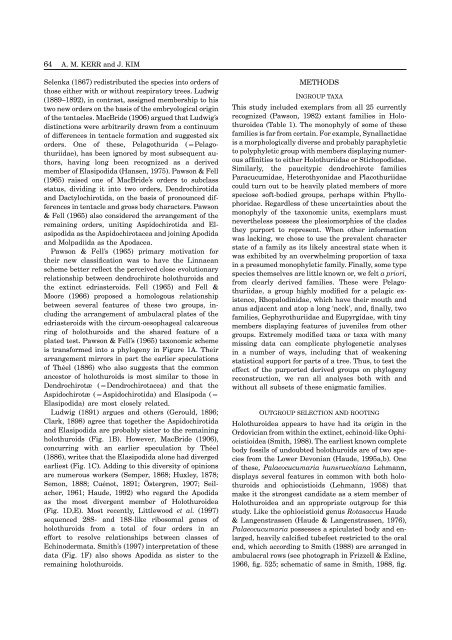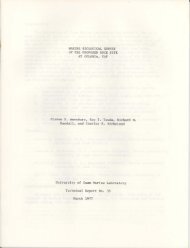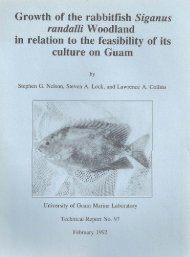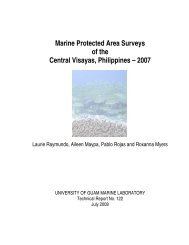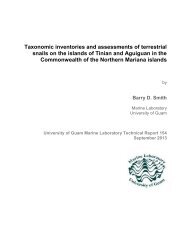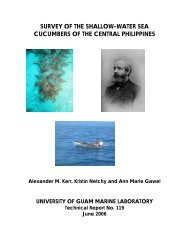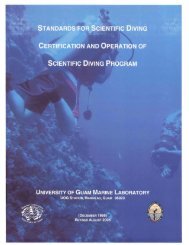Phylogeny of Holothuroidea (Echinodermata) inferred from ...
Phylogeny of Holothuroidea (Echinodermata) inferred from ...
Phylogeny of Holothuroidea (Echinodermata) inferred from ...
Create successful ePaper yourself
Turn your PDF publications into a flip-book with our unique Google optimized e-Paper software.
64 A. M. KERR and J. KIM<br />
Selenka (1867) redistributed the species into orders <strong>of</strong><br />
METHODS<br />
those either with or without respiratory trees. Ludwig<br />
(1889–1892), in contrast, assigned membership to his<br />
INGROUP TAXA<br />
two new orders on the basis <strong>of</strong> the embryological origin This study included exemplars <strong>from</strong> all 25 currently<br />
<strong>of</strong> the tentacles. MacBride (1906) argued that Ludwig’s recognized (Pawson, 1982) extant families in Holo-<br />
distinctions were arbitrarily drawn <strong>from</strong> a continuum thuroidea (Table 1). The monophyly <strong>of</strong> some <strong>of</strong> these<br />
<strong>of</strong> differences in tentacle formation and suggested six families is far <strong>from</strong> certain. For example, Synallactidae<br />
orders. One <strong>of</strong> these, Pelagothurida (=Pelagoto<br />
polyphyletic group with members displaying numer-<br />
is a morphologically diverse and probably paraphyletic<br />
thuriidae), has been ignored by most subsequent auous<br />
affinities to either Holothuriidae or Stichopodidae.<br />
thors, having long been recognized as a derived<br />
member <strong>of</strong> Elasipodida (Hansen, 1975). Pawson & Fell Similarly, the paucitypic dendrochirote families<br />
(1965) raised one <strong>of</strong> MacBride’s orders to subclass<br />
Paracucumidae, Heterothyonidae and Placothuriidae<br />
status, dividing it into two orders, Dendrochirotida<br />
could turn out to be heavily plated members <strong>of</strong> more<br />
and Dactylochirotida, on the basis <strong>of</strong> pronounced difphoridae.<br />
Regardless <strong>of</strong> these uncertainties about the<br />
speciose s<strong>of</strong>t-bodied groups, perhaps within Phyllo-<br />
ferences in tentacle and gross body characters. Pawson<br />
& Fell (1965) also considered the arrangement <strong>of</strong> the<br />
monophyly <strong>of</strong> the taxonomic units, exemplars must<br />
nevertheless possess the plesiomorphies <strong>of</strong> the clades<br />
remaining orders, uniting Aspidochirotida and Elthey<br />
purport to represent. When other information<br />
asipodida as the Aspidochirotacea and joining Apodida<br />
was lacking, we chose to use the prevalent character<br />
and Molpadiida as the Apodacea.<br />
state <strong>of</strong> a family as its likely ancestral state when it<br />
Pawson & Fell’s (1965) primary motivation for<br />
was exhibited by an overwhelming proportion <strong>of</strong> taxa<br />
their new classification was to have the Linnaean<br />
in a presumed monophyletic family. Finally, some type<br />
scheme better reflect the perceived close evolutionary<br />
species themselves are little known or, we felt a priori,<br />
relationship between dendrochirote holothuroids and<br />
<strong>from</strong> clearly derived families. These were Pelagothe<br />
extinct edriasteroids. Fell (1965) and Fell &<br />
thuriidae, a group highly modified for a pelagic ex-<br />
Moore (1966) proposed a homologous relationship<br />
istence, Rhopalodinidae, which have their mouth and<br />
between several features <strong>of</strong> these two groups, inanus<br />
adjacent and atop a long ‘neck’, and, finally, two<br />
cluding the arrangement <strong>of</strong> ambulacral plates <strong>of</strong> the<br />
families, Gephyrothuriidae and Eupyrgidae, with tiny<br />
edriasteroids with the circum-oesophageal calcareous<br />
members displaying features <strong>of</strong> juveniles <strong>from</strong> other<br />
ring <strong>of</strong> holothuroids and the shared feature <strong>of</strong> a<br />
groups. Extremely modified taxa or taxa with many<br />
plated test. Pawson & Fell’s (1965) taxonomic scheme missing data can complicate phylogenetic analyses<br />
is transformed into a phylogeny in Figure 1A. Their in a number <strong>of</strong> ways, including that <strong>of</strong> weakening<br />
arrangement mirrors in part the earlier speculations statistical support for parts <strong>of</strong> a tree. Thus, to test the<br />
<strong>of</strong> Théel (1886) who also suggests that the common effect <strong>of</strong> the purported derived groups on phylogeny<br />
ancestor <strong>of</strong> holothuroids is most similar to those in reconstruction, we ran all analyses both with and<br />
Dendrochirotæ (=Dendrochirotacea) and that the without all subsets <strong>of</strong> these enigmatic families.<br />
Aspidochirotæ (=Aspidochirotida) and Elasipoda (=<br />
Elasipodida) are most closely related.<br />
Ludwig (1891) argues and others (Gerould, 1896;<br />
OUTGROUP SELECTION AND ROOTING<br />
Clark, 1898) agree that together the Aspidochirotida <strong>Holothuroidea</strong> appears to have had its origin in the<br />
and Elasipodida are probably sister to the remaining Ordovician <strong>from</strong> within the extinct, echinoid-like Ophiholothuroids<br />
(Fig. 1B). However, MacBride (1906), ocistioidea (Smith, 1988). The earliest known complete<br />
concurring with an earlier speculation by Théel body fossils <strong>of</strong> undoubted holothuroids are <strong>of</strong> two spe-<br />
(1886), writes that the Elasipodida alone had diverged cies <strong>from</strong> the Lower Devonian (Haude, 1995a,b). One<br />
earliest (Fig. 1C). Adding to this diversity <strong>of</strong> opinions <strong>of</strong> these, Palaeocucumaria hunsrueckiana Lehmann,<br />
are numerous workers (Semper, 1868; Huxley, 1878; displays several features in common with both holo-<br />
Semon, 1888; Cuénot, 1891; Östergren, 1907; Seil- thuroids and ophiocistioids (Lehmann, 1958) that<br />
acher, 1961; Haude, 1992) who regard the Apodida make it the strongest candidate as a stem member <strong>of</strong><br />
as the most divergent member <strong>of</strong> <strong>Holothuroidea</strong> <strong>Holothuroidea</strong> and an appropriate outgroup for this<br />
(Fig. 1D,E). Most recently, Littlewood et al. (1997) study. Like the ophiocistioid genus Rotasaccus Haude<br />
sequenced 28S- and 18S-like ribosomal genes <strong>of</strong> & Langenstrassen (Haude & Langenstrassen, 1976),<br />
holothuroids <strong>from</strong> a total <strong>of</strong> four orders in an Palaeocucumaria possesses a spiculated body and eneffort<br />
to resolve relationships between classes <strong>of</strong> larged, heavily calcified tubefeet restricted to the oral<br />
<strong>Echinodermata</strong>. Smith’s (1997) interpretation <strong>of</strong> these end, which according to Smith (1988) are arranged in<br />
data (Fig. 1F) also shows Apodida as sister to the<br />
remaining holothuroids.<br />
ambulacral rows (see photograph in Frizzell & Exline,<br />
1966, fig. 525; schematic <strong>of</strong> same in Smith, 1988, fig.


